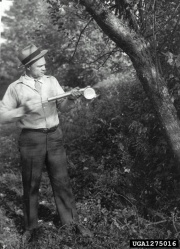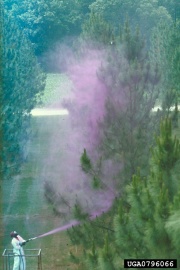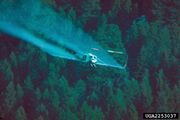Difference between revisions of "Insecticide"
(username removed) |
|||
| (6 intermediate revisions by 3 users not shown) | |||
| Line 1: | Line 1: | ||
[[File:DDT.treatment_sprayer_forestryimages.org.jpg|thumb|DDT insecticide]] | [[File:DDT.treatment_sprayer_forestryimages.org.jpg|thumb|DDT insecticide]] | ||
== Description == | == Description == | ||
| + | [[File:Insecticides_ground_forestryimages.org.jpg|thumb|Insecticide]] | ||
| + | Chemical products designed to kill insects. Insecticides can be classified as: | ||
| − | + | 1. Inorganic toxic compounds (e.g., soluble salts of [[arsenic]], [[lead]], [[mercury]], and [[copper]]) are consumed and act as stomach poisons. Silica absorbs the outer waxy covering and desiccates insects. | |
| − | + | 2. Natural organic compounds (e.g., [[pyrethrin]], [[rotenone]], [[nicotine]], [[copper naphthenate]], petroleum derivatives) are contact insecticides. | |
| − | + | 3. Synthetic organic compounds such as chlorinated (e.g., [[DDT]], [[aldrin]], [[chlordane]], [[lindane]]) contact insecticides are nonbiodegradable and many have been banned. Organic phosphates (e.g., [[parathion]], [[diazinon]], [[chlorpyrifos]], [[dichlorvos]], [[malathion]]) are toxic contact insecticides that are still in use. | |
| − | + | 4. Insect growth regulators (e.g., [[methoprene]], hydroprene, and [[fenoxycarb]]) prevent larvae from becoming adults. | |
| − | + | 5. Fumigants (e.g., [[sulfuryl fluoride]] and [[methyl bromide]]) are vapor phase insecticides that penetrate inaccessible locations. | |
| − | + | 6. Anoxic storage using oxygen scavengers ([[Ageless]], VELOXY) in an airtight container kills all stages of insects (adults, eggs, larvae, and pupae). | |
| − | + | [[File:Insecticides_helicopter_forestryimages.org.jpg|thumb|Insecticide]] | |
| − | + | == Risks == | |
| − | == | ||
All insecticides are potentially toxic to humans and animals. Pyrethrins, rotenone and methoxychlor are the least toxic because they quickly decompose. | All insecticides are potentially toxic to humans and animals. Pyrethrins, rotenone and methoxychlor are the least toxic because they quickly decompose. | ||
| − | == | + | == Resources and Citations == |
| − | |||
| − | |||
| − | |||
| − | |||
| − | |||
| − | |||
| − | |||
| − | |||
| − | |||
| − | |||
| − | |||
* Lynda A. Zycherman, J.Richard Schrock, ''A Guide to Museum Pest Control'', FAIC and Association of Systematics Collections, Washington DC, 1988 | * Lynda A. Zycherman, J.Richard Schrock, ''A Guide to Museum Pest Control'', FAIC and Association of Systematics Collections, Washington DC, 1988 | ||
| Line 42: | Line 32: | ||
* Tom Rowland, Noel Riley, ''A-Z Guide to Cleaning, Conserving and Repairing Antiques'', Constable and Co., Ltd., London, 1981 | * Tom Rowland, Noel Riley, ''A-Z Guide to Cleaning, Conserving and Repairing Antiques'', Constable and Co., Ltd., London, 1981 | ||
| − | * ''Encyclopedia Britannica'', http://www.britannica.com Comment: "Insecticide." | + | * ''Encyclopedia Britannica'', http://www.britannica.com Comment: "Insecticide." Accessed (7 Sept. 2004). |
* ''Van Nostrand's Scientific Encyclopedia'', Douglas M. Considine (ed.), Van Nostrand Reinhold, New York, 1976 | * ''Van Nostrand's Scientific Encyclopedia'', Douglas M. Considine (ed.), Van Nostrand Reinhold, New York, 1976 | ||
Latest revision as of 15:32, 20 September 2022
Description
Chemical products designed to kill insects. Insecticides can be classified as:
1. Inorganic toxic compounds (e.g., soluble salts of Arsenic, Lead, Mercury, and Copper) are consumed and act as stomach poisons. Silica absorbs the outer waxy covering and desiccates insects.
2. Natural organic compounds (e.g., Pyrethrin, Rotenone, Nicotine, Copper naphthenate, petroleum derivatives) are contact insecticides.
3. Synthetic organic compounds such as chlorinated (e.g., DDT, Aldrin, Chlordane, Lindane) contact insecticides are nonbiodegradable and many have been banned. Organic phosphates (e.g., Parathion, Diazinon, Chlorpyrifos, Dichlorvos, Malathion) are toxic contact insecticides that are still in use.
4. Insect growth regulators (e.g., Methoprene, hydroprene, and Fenoxycarb) prevent larvae from becoming adults.
5. Fumigants (e.g., Sulfuryl fluoride and Methyl bromide) are vapor phase insecticides that penetrate inaccessible locations.
6. Anoxic storage using oxygen scavengers (Ageless, VELOXY) in an airtight container kills all stages of insects (adults, eggs, larvae, and pupae).
Risks
All insecticides are potentially toxic to humans and animals. Pyrethrins, rotenone and methoxychlor are the least toxic because they quickly decompose.
Resources and Citations
- Lynda A. Zycherman, J.Richard Schrock, A Guide to Museum Pest Control, FAIC and Association of Systematics Collections, Washington DC, 1988
- J. Dawson, CCI Technical Bulletin, 'Solving Museum Insect Problems: Chemical Control' , Canadian Conservation Institute, Ottawa, No. 15
- Caring for your Collections, Arthur W Schulz (ed.), Harry N. Abrams, Inc. , New York, 1992
- Tom Rowland, Noel Riley, A-Z Guide to Cleaning, Conserving and Repairing Antiques, Constable and Co., Ltd., London, 1981
- Encyclopedia Britannica, http://www.britannica.com Comment: "Insecticide." Accessed (7 Sept. 2004).
- Van Nostrand's Scientific Encyclopedia, Douglas M. Considine (ed.), Van Nostrand Reinhold, New York, 1976
- Random House, Webster's Encyclopedic Unabridged Dictionary of the English Language, Grammercy Book, New York, 1997
- The American Heritage Dictionary or Encarta, via Microsoft Bookshelf 98, Microsoft Corp., 1998
- Art and Architecture Thesaurus Online, http://www.getty.edu/research/tools/vocabulary/aat/, J. Paul Getty Trust, Los Angeles, 2000


